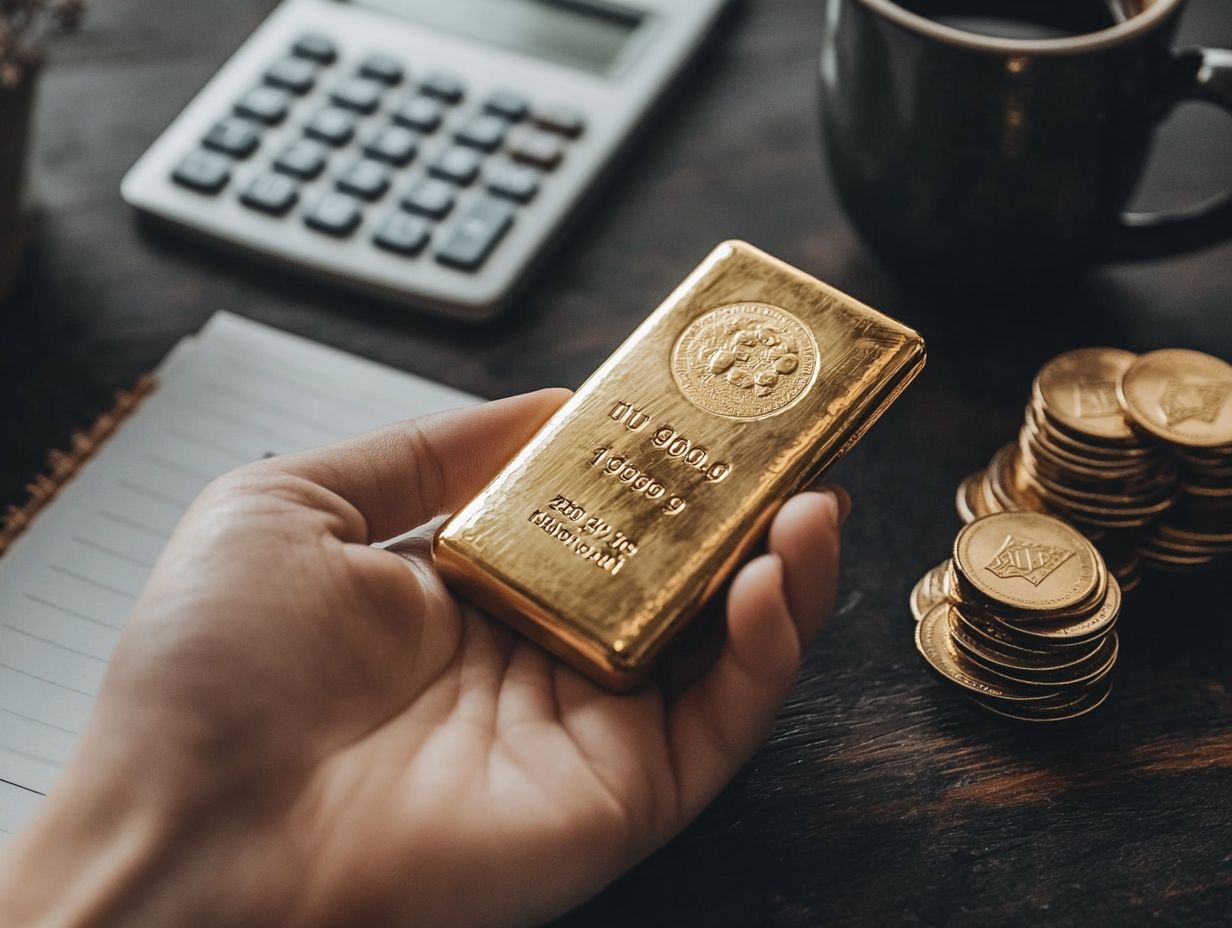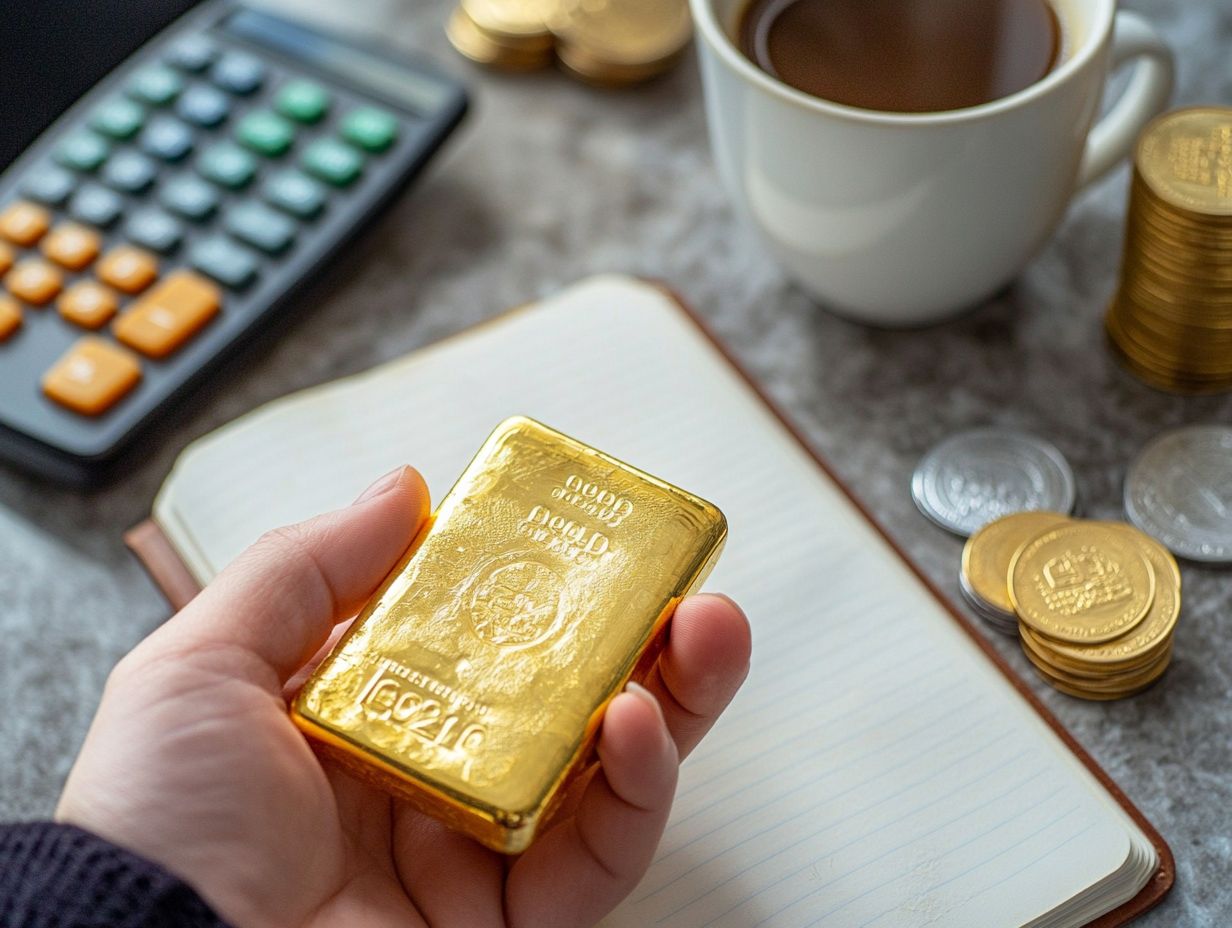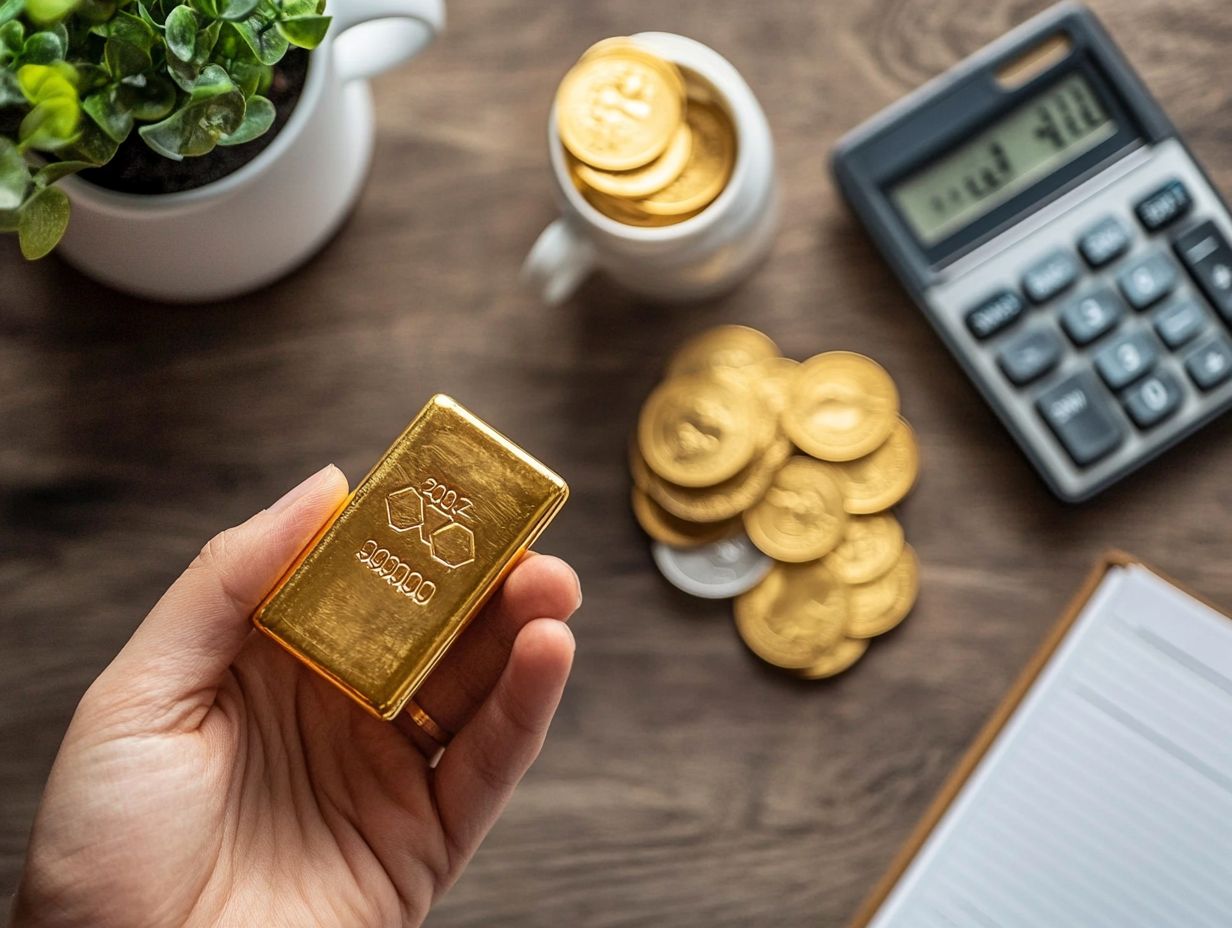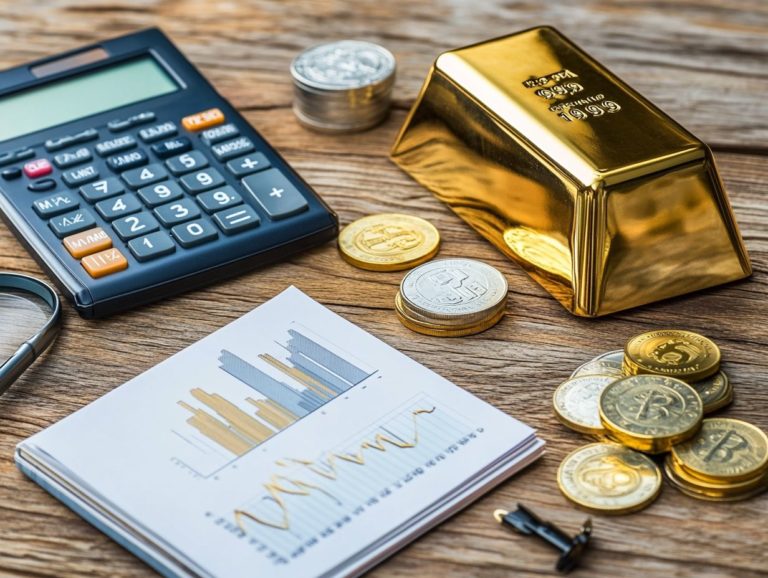How to Set Investment Goals for Precious Metals
Investing in precious metals can be a rewarding yet intricate journey. With a variety of metals at your disposal and ever-changing prices, managing these investments demands meticulous planning.
Get ready to explore the fascinating world of precious metals! This article covers different types of precious metals, the factors that drive their prices, and the crucial reasons for setting investment goals. Whether you’re seeking short-term gains or aiming for long-term security, this guide will help you evaluate your financial circumstances, pinpoint your objectives, and formulate an actionable plan to achieve your investment ambitions.
Prepare to discover practical tips that will pave your way to success in precious metal investments!
Contents
- Key Takeaways:
- Understanding Precious Metals as an Investment
- Why Set Investment Goals for Precious Metals
- Key Considerations for Setting Investment Goals
- Types of Investment Goals for Precious Metals
- Steps to Setting Investment Goals for Precious Metals
- Tips for Achieving Investment Goals
- Frequently Asked Questions
- What are the benefits of setting investment goals for precious metals?
- How do I determine my investment goals for precious metals?
- Should I have different goals for different types of precious metals?
- What is a reasonable timeline for achieving investment goals for precious metals?
- How often should I review my investment goals for precious metals?
- Why is it important to track my progress towards investment goals?
Key Takeaways:

- Understand the types of precious metals and the factors affecting their prices to make informed investment decisions.
- Set investment goals for precious metals to reap the benefits of goal setting, such as increased focus and motivation.
- Consider risk tolerance and time horizon when setting investment goals to align with your personal financial situation and objectives.
Understanding Precious Metals as an Investment
Understanding precious metals as an investment is vital if you’re considering diversifying your portfolio, especially during times of economic uncertainty.
Metals like gold, silver, platinum, and palladium offer unique advantages as safe havens and inflation hedges. This makes them essential components of a strong investment strategy.
As you look for ways to preserve wealth, these precious metals stand out as worthy options to explore due to their historical significance and tangible value.
Types of Precious Metals
The primary types of precious metals you might consider as an investor include gold, silver, platinum, and palladium. Each offers unique investment opportunities and characteristics.
Gold has timeless allure and often serves as a safe haven during economic uncertainties, making it a staple in many portfolios.
Silver, often dubbed the “poor man’s gold,” plays a crucial role in industrial applications, particularly in electronics and photovoltaics, while appealing to investors.
Platinum is rarer and generally more expensive, chiefly utilized in automotive catalytic converters. Its demand is closely tied to the automotive industry’s performance. Meanwhile, palladium has garnered attention due to its scarcity and increasing use in pollution control.
You can diversify your exposure to these metals through various avenues, such as acquiring physical bullion, investing in mining stocks that reflect market conditions, or exploring ETFs that track precious metal indexes. It’s also important to consider the tax implications of investing in precious metals ETFs. Recent market trends have shown a growing interest in sustainable mining practices, adding an extra layer of appeal for the conscientious investor.
Factors Affecting Prices
Several factors significantly influence the prices of precious metals. You should be aware of supply and demand dynamics, geopolitical issues, and various economic indicators that shape market trends.
Currency fluctuations are particularly crucial. A weaker dollar often makes metals more affordable for overseas buyers, driving up demand and prices. Market manipulation by large investors can create artificial volatility, impacting short-term price movements in unexpected ways.
Specific events in the United States, such as changes in interest rates or inflation reports, can trigger shifts in investor sentiment and alter market dynamics.
On a global scale, factors like trade tensions or natural disasters can disrupt supply chains, further influencing metal availability and pricing. By understanding these interconnected elements, you can gain valuable insights into the ever-changing landscape of precious metal investments.
Why Set Investment Goals for Precious Metals
You must establish investment goals for precious metals to preserve your wealth and effectively navigate economic uncertainties. By doing so, you create a clear roadmap for your investment strategy and diversification efforts. This ensures that your choices align with your financial aspirations.
Don t wait! Start exploring precious metal investments today to secure your financial future.
Benefits of Goal Setting
The benefits of goal setting are abundant, providing you with a structured framework to navigate investment risks and seize valuable opportunities in the precious metals sector.
Defining clear financial objectives helps create a roadmap that guides your strategies toward achieving financial stability. This method promotes disciplined investing and fosters accountability as you track your progress.
With specific goals in mind, you can allocate your resources more effectively, minimizing impulsive decisions. Setting milestones allows for periodic performance assessments, ensuring alignment with your long-term vision while adapting to any market fluctuations.
Key Considerations for Setting Investment Goals

When setting investment goals for precious metals, consider key factors like your risk tolerance and time horizon. These elements are fundamental in shaping a robust investment strategy tailored to your financial landscape.
Risk Tolerance and Time Horizon
Risk tolerance and time horizon are vital factors shaping your investment goals, especially in the realm of precious metals during economic uncertainty.
Understanding these elements is crucial; your personal risk appetite how much risk you are willing to take greatly influences the types of assets you re comfortable holding. For instance, if you prefer a conservative approach, you might gravitate toward safer strategies, favoring stable precious metals like gold, historically a hedge against inflation.
If you have a more aggressive mindset, you may explore investments in silver or emerging metal markets, dynamically responding to market conditions. For those interested in diversifying with ETFs, learning how to use ETFs for precious metals investment can be beneficial. Aligning these choices with your time horizon allows for a customized strategy, ensuring your financial decisions support your long-term objectives while navigating the unpredictable tides of economic fluctuations.
Types of Investment Goals for Precious Metals
Investment goals for precious metals can be categorized into short-term versus long-term goals and specific versus general goals. Each category demands unique strategies and tailored approaches.
Short-term vs. Long-term Goals
Understanding the distinction between short-term and long-term goals is essential for crafting an effective investment strategy in precious metals.
Short-term goals focus on immediate returns, employing strategies that leverage market volatility for quick profits. In contrast, long-term goals emphasize stability and gradual growth, relying on meticulous analysis to pinpoint trends that may take years to develop.
For example, focusing on short-term objectives may lead to swift adjustments based on market dynamics. In contrast, those with long-term goals likely prioritize solidifying their positions in established assets, contributing to a diversified investment portfolio that can weather market fluctuations.
Specific vs. General Goals
Differentiate between specific and general goals when investing in precious metals, as each serves its unique purpose.
Specific goals, like aiming for a particular return or acquiring a set amount of gold within a timeframe, enhance your ability to plan and execute strategies with precision. Clear targets equip you to develop tailored approaches aligning with your financial aspirations.
General goals such as wealth preservation or diversification steer the overall direction of your investments. Striking a balance between these types enables informed decisions, ensuring strategies remain flexible and aligned with your long-term vision, contributing to a robust and resilient portfolio.
Seize the opportunity to set your investment goals today! Act wisely now to secure your financial future!
Steps to Setting Investment Goals for Precious Metals
Setting investment goals for precious metals requires you to navigate a few essential steps. Begin by thoroughly assessing your current financial situation. Next, pinpoint your specific investment objectives. Finally, craft a well-structured action plan that aligns with your goals, ensuring a strategic approach to your investments.
Assessing Current Financial Situation

Assessing your current financial situation is an essential first step in setting your investment goals for precious metals. This process gives you a clear view of your investments and how much risk you can handle.
By thoroughly understanding your assets, liabilities, and cash flow, you can pinpoint the strengths and weaknesses within your financial landscape. This clarity not only helps you establish realistic goals but also plays a critical role in determining how much risk you can comfortably take.
Looking at how your past investments have done can unveil patterns and trends that refine your future strategies. Ultimately, this detailed financial assessment gives you the power to make informed decisions, aligning your approach with market dynamics and your personal aspirations, enhancing your overall confidence in your investing journey.
Identifying Investment Objectives
Identifying clear investment objectives is essential for aligning your precious metals investments with your overarching goals, such as wealth preservation and effective risk management.
Setting specific and measurable investment objectives serves as your roadmap for financial success. By clearly defining what you aim to achieve, whether it’s capital appreciation, income generation, or protecting assets against economic fluctuations, you empower yourself to make more informed decisions. For those interested in metals, using futures for precious metals investment can be a strategic approach.
This clarity enables you to assess various trading strategies, ensuring they are tailored to meet your objectives. By incorporating elements like market trends, how quickly you might need to sell your investments, and personal risk tolerance into your goals, you enrich your decision-making process. Additionally, understanding the best practices for precious metals investment can further enhance your approach.
Adopting this strategic mindset ultimately paves the way for a more disciplined approach to navigating the complexities of precious metals trading.
Creating an Action Plan
Creating an action plan is crucial for transforming your investment goals into tangible steps, establishing a clear path forward in your precious metals investment strategy.
This roadmap not only outlines your necessary objectives but also defines the resources you ll need and the specific actions required to reach those milestones. An effective action plan uses a straightforward approach that considers your initial goals and the changing market conditions.
Regularly monitoring and adjusting your strategy is vital, as shifts in market trends may require you to change your approach. Consistently evaluating your progress and reassessing your plans ensures you stay on track and aligned with current economic indicators, maximizing your potential returns.
Tips for Achieving Investment Goals
To crush your investment goals in precious metals, you need a powerful mix of consistency and discipline. It s essential to proactively monitor and adjust your strategies to navigate this dynamic market effectively.
Consistency and Discipline
Consistency and discipline serve as the cornerstones of your successful investment strategy in precious metals, helping you maintain focus on your goals even amid market fluctuations.
By sticking to a well-defined approach, you can effectively mitigate the challenges posed by market volatility and sidestep common pitfalls. Emotional decision-making can lead to reactive behaviors like panic selling during downturns or overly optimistic buying during peaks that jeopardize your long-term financial goals.
Implementing a strategic plan gives you the power to make research-backed decisions rather than succumbing to impulsive reactions. This disciplined mindset helps preserve your capital and positions you to seize opportunities when the market is in your favor, ultimately fostering sustained growth in your precious metals portfolio. Understanding tax strategies for investing in precious metals ETFs can also enhance your investment approach.
Monitoring and Adjusting Goals
Regularly monitoring and adjusting your investment goals is essential. This keeps you aligned with the changing market landscape.
To track your investment performance effectively, use a mix of analytical tools and methods. Setting benchmarks and conducting regular reviews will highlight areas needing your attention.
Utilize resources like financial news and economic indicators to make informed decisions. This proactive approach maximizes returns and helps mitigate risks.
Frequently Asked Questions

What are the benefits of setting investment goals for precious metals?
Setting investment goals for precious metals gives you clarity on your financial objectives. It also motivates you to stay on track and achieve your desired results.
How do I determine my investment goals for precious metals?
Start by assessing your financial situation and risk tolerance. Consider your short-term and long-term financial objectives to set realistic goals.
Should I have different goals for different types of precious metals?
A diversified portfolio is recommended, so having specific goals for each type of precious metal can balance risk and potential returns.
What is a reasonable timeline for achieving investment goals for precious metals?
Your timeline depends on your financial situation and goals. Set a realistic timeline considering market fluctuations.
How often should I review my investment goals for precious metals?
Review your investment goals yearly! This allows you to assess your progress and adjust based on changes in your financial situation.
Why is it important to track my progress towards investment goals?
Tracking your progress helps you stay accountable and make adjustments if needed. You ll also feel a sense of accomplishment as your investments grow.















